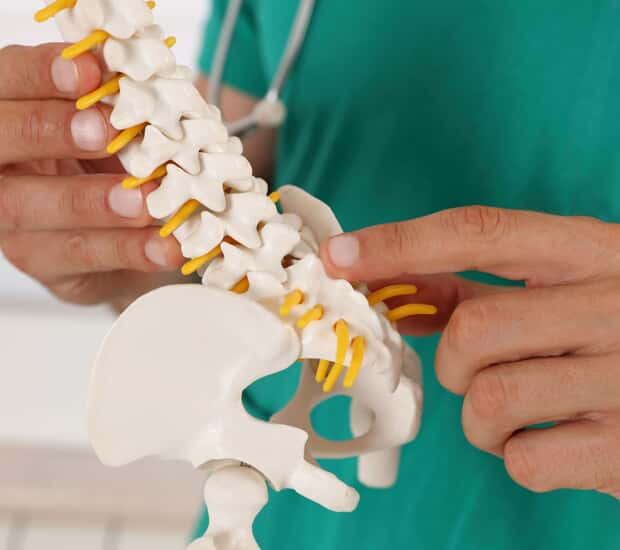Interventional Spine TreatmentsAustell, GA
Interventional spine treatments provide effective, non-surgical solutions for patients experiencing back, neck, or spinal pain. Offered by orthopedic doctors or PA-Cs (Physician Assistant-Certified), these treatments address pain and improve mobility by targeting specific areas of discomfort along the spinal cord and throughout the back. Understanding the types of interventional spine treatments available and their benefits can help patients find relief while avoiding invasive surgical procedures.
Delta Orthopedics offers interventional spine treatments, such as pain management injections, in Austell. We can help you explore your options in a consultation. Contact our office at 678-439-5216 today to get started.
The Basics of Interventional Spine Treatments
Interventional spine treatments are advanced orthopedic procedures that address spine-related pain and improve overall functionality while minimizing recovery times. These minimally invasive techniques provide an alternative to traditional surgery by targeting the underlying sources of discomfort with precision. One common treatment includes facet joint injections, which focus on easing discomfort in the joints connecting the vertebrae caused by arthritis or injury.
Other options include radiofrequency ablation (RFA), which uses heat to interrupt pain signals for long-term relief from chronic conditions, and trigger point injections that target specific areas of muscle pain and tension. On the other hand, regenerative medicine techniques, such as platelet-rich plasma (PRP) therapy, harness the body's natural healing ability to repair damaged tissues and promote recovery. Each treatment plan is customized to meet the patient's needs and deliver better health outcomes.
“These minimally invasive techniques provide an alternative to traditional surgery by targeting the underlying sources of discomfort with precision”
Benefits of Interventional Spine Treatments
The main benefit of interventional spine treatments is their ability to manage pain and improve quality of life without requiring surgery. By directly targeting the source of discomfort, they provide effective and often quick relief. Since they are minimally invasive, these treatments also have a shorter recovery time.
Another benefit is their long-lasting results. Some options, like radiofrequency ablation, deliver relief that can extend for months or even years. Regenerative medicine further enhances outcomes by stimulating the body's natural ability to heal and repair damaged tissues. These combined benefits make interventional spine treatments a reliable choice for managing pain and improving functionality.
“The main benefit of interventional spine treatments is their ability to manage pain and improve quality of life without requiring surgery.”
Signs You May Need Interventional Spine Treatments
While interventional spine treatments address persistent or debilitating spinal pain, they are often recommended for patients who have not found relief through conventional treatments but still want to avoid surgery. However, not everyone may be a candidate for this treatment. Common signs that patients may benefit from interventional spine treatments include chronic back or neck pain, frequent muscle spasms, or pain radiating down the arms or legs (radicular pain).
It is recommended to ask a proper medical professional about interventional spine treatments if these symptoms are causing limited mobility and interfering with daily activities. This is particularly true if over-the-counter (OTC) and prescription medications have brought little to no relief.
“Common signs that patients may benefit from interventional spine treatments include chronic back or neck pain, frequent muscle spasms, or pain radiating down the arms or legs (radicular pain).”
What To Expect From Interventional Spine Treatments
The process for interventional spine treatments begins with a comprehensive evaluation by an orthopedic doctor or PA-C. This initial assessment includes a detailed review of the patient's medical history and symptoms to better understand the nature of their condition. Physical examinations and imaging tests, such as X-rays or MRIs, can also help identify the exact source of pain and ensure an accurate diagnosis. Then, they will go over available treatment options and set realistic expectations for what the patient can expect.
During the treatments itself, a local anesthetic is typically administered to ensure comfort. Treatments such as injections or radiofrequency ablation are often performed with the assistance of advanced imaging technology, allowing for precise instrument placement and targeted relief. Most interventional spine treatments are completed within an hour, and patients can return home the same day.
“The process for interventional spine treatments begins with a comprehensive evaluation by an orthopedic doctor or PA-C.”
Healing and Recovery
Proper healing and recovery help maximize the benefits of interventional spine treatments and foster long-term improvements in mobility and quality of life. The first step is to rest and avoid heavy lifting or strenuous activities. This protects the spine and allows it to heal. An orthopedic doctor or PA-C will likely recommend regular follow-up appointments to track progress and make any necessary adjustments to the recovery plan.
Physical therapy is often a cornerstone of the recovery process, as it incorporates exercises to strengthen the muscles that support the spine and improve mobility. At home, patients can take simple measures, like using hot or cold packs, to manage residual discomfort while maintaining proper posture that supports spinal alignment. Adopting a healthy lifestyle — including a balanced diet, regular physical activity, and avoiding harmful habits like smoking — promotes overall well-being and prevents further spinal issues.
“The first step is to rest and avoid heavy lifting or strenuous activities.”
Questions Answered on This Page
Q. What are interventional spine treatments?
Q. What are the benefits of interventional spine treatments?
Q. What are the signs that a patient may need interventional spine treatments?
Q. What is the process behind interventional spine treatments?
Q. What is the recovery like from interventional spine treatments?
Find Lasting Relief with Interventional Spine Treatments
Discover effective, non-surgical solutions for your back and neck pain. Schedule a consultation with Delta Orthopedics at 678-439-5216 today to learn more about interventional spine treatments tailored to your needs. We help patients in Austell and the surrounding communities manage their symptoms so they can get back to what matters most.
Frequently Asked Questions
Q. Do interventional spine treatments hurt?
A. Most interventional spine treatments involve minimal discomfort, as local anesthesia to numb the area beforehand. Whether the treatment involves injections, radiofrequency ablation, or other techniques, patients may experience mild pressure or a brief sensation of discomfort during the process. Any resulting soreness or tenderness should go away within a day or two of treatment.
Q. Can interventional spine treatments help with herniated discs?
A. Yes, interventional spine treatments are highly effective in managing pain caused by herniated discs. For example, radiofrequency ablation can be used for persistent symptoms. Call our office to learn how we can address herniated disc-related pain and inflammation.
Q. How long do the effects of these treatments last?
A. The duration of relief varies depending on the specific treatment and the patient's condition. For example, trigger point injections last for about a month, while facet joint injections may provide relief for three to six months. Regular follow-ups allow the PA-C to work toward lasting pain relief for the patient.
Q. What is the recovery time for these procedures?
A. Recovery time for interventional spine treatments is typically short, with most patients resuming light activities on the same day. Full recovery, including the ability to return to regular routines, generally occurs within a few days. Following post-treatment instructions, such as avoiding strenuous activity for 24 hours, helps ensure a smooth recovery and maximizes the effectiveness of the treatment.
Q. How do I know if interventional spine treatments are right for me?
A. An orthopedic doctor or PA-C can help determine whether a patient is a good candidate for interventional spine treatments. These treatments are often recommended for conditions like herniated discs, spinal stenosis, or chronic back pain unresponsive to conservative methods. Thus, the PA-C will ask about symptoms and use diagnostic imaging to help identify the root cause of pain and the best treatment approach.
Definitions
- Radiofrequency ablation.
- A procedure using heat to interrupt nerve signals and reduce pain.
- Trigger point injection.
- Techniques that stimulate natural tissue repair and healing.
- Regenerative medicine.
- Techniques that stimulate natural tissue repair and healing.
- Radicular pain.
- Pain radiating from the spine into the arms or legs due to nerve irritation.
- MRI.
- Formally known as magnetic resonance imaging, this is an imaging technique used to diagnose medical conditions.
- Spinal alignment.
- The proper positioning of the spine, which supports balance, mobility, and nerve function.
- Minimally invasive.
- Procedures that do not involve large incisions, reducing recovery time and tissue damage.
- Conventional treatments.
- Standard methods like medication or therapy used before advanced procedures.
- Facet joint injection.
- A treatment to alleviate pain in the small joints of the spine.
Contact Us
Delta Orthopedics is located at
1790 Mulkey Rd Build 9 Suite 1314
Austell, GA 30106





